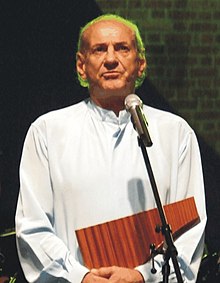Gheorghe Zamfir
| Gheorghe Zamfir | |
|---|---|
 |
|
| Background information | |
| Birth name | Gheorghe Zamfir |
| Also known as | Pan Flute Master |
| Born |
April 6, 1941 Găeşti, Romania |
| Genres |
Romanian popular music Instrumental Pop Easy listening |
| Occupation(s) | Musician, Songwriter, Music teacher |
| Instruments | Pan flute |
| Years active | 1960 - present |
| Labels | SonArt, Philips, Mercury |
| Website | www.gheorghe-zamfir.com |
Gheorghe Zamfir (Romanian pronunciation: [ˈɡe̯orɡe zamˈfir]; born April 6, 1941) is a Romanian pan flute musician.
Zamfir is known for playing an expanded version of the traditional Romanian-style pan flute (nai) of 20 pipes to 22, 25, 28 and 30 pipes to increase its range, and obtaining as many as eight overtones (additionally to the fundamental tone) from each pipe by changing the embouchure.
He is known as "The Master of the Pan Flute".
Zamfir came to the public eye when he was approached by Swiss ethnomusicologist Marcel Cellier, who extensively researched Romanian folk music in the 1960s. The composer Vladimir Cosma brought Zamfir with his pan flute to Western European countries for the first time in 1972 as the soloist in Cosma's original music for the movie Le grand blond avec une chaussure noire. This was very successful, and since then, he has been used as soloist in movie soundtracks by composers Francis Lai, Ennio Morricone and many others. Largely through television commercials where he was billed as "Zamfir, Master of the pan Flute", he introduced the folk instrument to a modern audience and revived it from obscurity.
In 1966, Zamfir was appointed conductor of the "Ciocîrlia Orchestra", one of the most prestigious state ensembles of Romania, destined for concert tours abroad. This created the opportunity for composition and arranging. In 1969, he left Ciocîrlia and started his own small band (taraf) and in 1970 he had his first longer term contract in Paris. Zamfir discovered the much greater freedom for artistic adventure. His taraf consisted of: Ion Drăgoi (violin), Ion Lăceanu (flutes), Dumitru Fărcaș (tarogato), Petre Vidrean (double bass) and Tony Iordache (cymbalum) all number 1 soloists in their country. This taraf made some excellent recordings (CD Zamfir a Paris). He changed the composition of the band soon after: Efta Botoca (violin), Marin Chisar (flutes), Dorin Ciobaru and Pavel Cebzan (clarinet and tarogato), Petre Vidrean (bass) and Pantelimon Stînga (cymbalum). It is said that this change was made to increase the command of Zamfir and have more artistic freedom. A turning point was the recording of Zamfir's composition "Messe pour la Paix" (Philips). His taraf joined a choir and a symphonic orchestra. This was evidence of the growing ambition. While the Philips recordings of that time were rather conservative, Zamfir preached revolution in the concert halls with daring performances. Some say that this short period was the highlight of his career. In 1977, he recorded "The Lonely Shepherd" with James Last. Zamfir put himself on the world map and since then his career became highly varied, hovering over classical repertoire, easy listening and pop music.
...
Wikipedia
